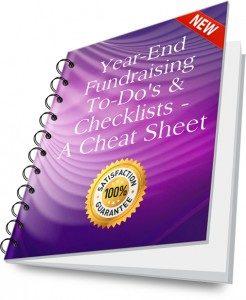
Magic happens when you care and share.
It’s a scary world out there.
Is there a magic wand you can wave to keep your donors close while living in a socially distanced world?
Getting up close and personal with donors has always been the gold standard killer strategy for generating passionate gifts and keeping donors loyal. But we didn’t take the term “killer” literally!
Today it’s simply too dangerous for folks to leave home.
So… what can you do instead? Plenty!
Thanks not only to digital technology, but also to familiar tools like the telephone and snail mail, it can be pretty easy to stay attuned and in touch even when practicing social distancing.
Your ‘donor love’ wand still has an abundance of fundraising and donor stewardship magic in it, if you just think a bit creatively. And it doesn’t have to cost you a lot of money.
Today I want to share with you some of my favorite ‘wand wave’ tricks for end-of-year fundraising season. Depending on who you connect with, and how you tweak your message, they work to:
- Acquire new donors
- Retain existing donors
- Upgrade existing donors
Consider your goals first. Then pick from among these strategies.
Even if you just do one of these things between now and the end of the year, you’ll boost your fundraising results.
1. Check-in call
If you use the telephone, this requires no digital skills and it’s something anyone can do. We’re living in a time of isolation, when outreach from others is welcomed more than ever. People who might otherwise not have picked up the phone will pick it up now. Especially if it comes from a name they recognize. (So make sure you have caller I.D. turned on when you place your call.) Other staff can make calls too. As can board members. You can also send an email first, and set up a Zoom, Facetime or Skype call for your donors who use these mediums. Consider this especially for your major donors who’ve not yet made their gift this calendar (or fiscal) year. Tell them you’re thinking about them during this time of year when we reflect on our blessings. Tell them you’re grateful to them. Ask them how they’re doing. Ask them what they’re concerned about right now. If they ask how your organization is doing, certainly update them. But make this call more about their agenda than yours. You didn’t call to make a speech. You called to show you care. Show you treasure these amazing folks as people, not just as ATMs.
While you’re on the call, thank folks for their past support. This reminds them of their past decision to give to you, which works as a decision-making shortcut for this year. Committed consistent donors want to stay that way! It’s actually one of Robert Cialdini’s Principles of Influence that affect human behaviors. Folks are social creatures bent on creating and sustaining social bonds. If they’ve said “yes” to you once they’re more likely to do so again to demonstrate their consistency and commitment. The call warms them up for the ask that soon follows. As humans, we operate a lot on reciprocity. When you give someone something – including meaningful recognition, gratitude and the gift of listening – it inclines them naturally to want to give back.
2. Personal email
Create a list of folks who’d appreciate a truly personal email from you; one that shows they are special. Not a mass email, but one you clearly took the time to write especially for them. Perhaps they’re prospects on your mid-level or major donor cultivation portfolios. Or they could be monthly donors, board members, committee members, loyal direct service volunteers, donors to a particular program or campaign, or donors who make a gift that is above average size for other donors in their category. Make the list manageable so you’ll really do it!
If you can’t take the time to personally email everyone on your list – one at a time – consider a templated email which you personalize to a reasonable extent (e.g., donor’s first name for salutation; indication you know them through language recognizing their service/affiliation – “as a board member, you understand better than most…,” and so forth). Make sure the sender’s name is recognizable, and do not use a noreply@email which just frustrates those who’d like to respond. Use a real person’s email. Include a phone number too. And be prepared to respond individually, and with an upbeat, conversational tone. The whole point of these ‘waves of your wand’ is to build stronger relationships with your supporters.
3. Virtual town hall
People are more and more using platforms like Zoom, YouTube and Facebook Live to connect with supporters in real time. Some organizations are being more transparent than ever before, treating their donors like insiders who can handle the truth and help them problem solve. Send an email invitation to your email list inviting them to register to join you for a specific date and time where you’ll look forward to having a conversation with them about current issues in your field. It can be a heart-to-heart with the CEO or you can add in other VIPs such as doctors, scientist, artists and so forth. You can also send a postcard to folks for whom you only have snail mail addresses. If you’ve a text-savvy demographic, by all means send your invitation this way. People love to interact with the folks responsible for putting their philanthropy into action, and this can be a wonderful way to pre-suade them to make a year-end gift. An alternative to video conferencing is to set this up purely as a conference call that uses the good old telephone.
4. Virtual entertainment event
Virtual events are the newest entertainment medium. They can also serve as fundraisers, before, during and after the fact. Arts organizations are hosting virtual play readings, tours of museum exhibits, talks with choreographers and the like. Educational organizations are zooming classes of all kinds for folks of all ages. Social justice organizations are hosting interactive town halls to discuss issues of the day. Health care organizations are sharing “how to” videos for staying safe and taking care of others. After the event, send follow-up emails with sharable links to videos and donation requests. Find ideas for virtual events here and here.
5. Story worth sharing
Stories draw people in, helping them imagine the possibility they can create with their support. It is a thousand times better to share a visual story – either an actual video or a story told with vivid, descriptive details – than an email replete with facts and figures. There’s a reason news organizations don’t just show graphs of mind-numbing figures to describe tragic events. They also share stories of individual people to whom viewers can relate. These are what make folks ultimately open their hearts and wallets. Take some time to consider a story of yours worth sharing right now. If it’s already on tape, share it via email, text and social media. If it’s not yet recorded, you know what to do. If you absolutely can’t record, take a snapshot and tell the story as emotionally as you can. Also, take a moment to consider the stories your donors are most likely to want to hear. If you do, they’re more apt to pay attention.
6. Thank you call.
Plan ahead now to make grateful phone calls to donors who make gifts now. Again, this is easy and anyone who is warm and friendly can do it – board members included. Don’t skip this important stewardship step! Prompt thank you calls definitely improve donor retention and are even predictive of increased giving the following year. If you can’t call everyone, at least call a selected subset. For more information and a suggested thank you script, grab my free Donor Thank You Calls e-book here. You can even make it fun for callers by giving prizes for the most calls made, longest conversation, most spontaneous gifts received, etc.
7. Thank you video.
Simply shoot a short (15 – 20 seconds) video on your smart phone of you saying thank you. You can get fancier and videotape staff or beneficiaries saying thanks, but don’t worry if this is too hard to pull together right now. There are other tools you can use too, such as bombbomb and covideo. But simple is just fine. No need for a film degree or fancy camera. Amateur is even better than professional. For major donors, send something personalized made just for them. Here’s an example Rachel Muir recently shared from a theater company in Topeka. And another example from the Humane Society of Georgia. Pure gold! You can find more ideas, short and long, on my Pinterest board: Gratitude – Nonprofits Say Thanks. And don’t forget you can share these videos not just via email, but also via text (perhaps with a tool like textology) and social media. Try to pick the medium(s) your donors prefer so you maximize the chances your video will be opened and appreciated.
8. Handwritten thank you note.
It’s special these days to receive a handwritten thank you note. I promise, if you do this for your donors – even if it’s just a targeted subset – people will notice. No jargon. No boilerplate. Write from your heart. Brief is swell, but don’t just sign your name to a Hallmark card. That’s a waste of a stamp. Say something warm and personal. Poor handwriting is no longer a good excuse; you can try one of these apps for handwritten, personalized thank you cards.
Thank you notes are appropriate more than once. Certainly a card following a gift makes sense. And it’s a terrific idea to supplement an email receipt, especially if it comes from someone within your organization from whom the donor did not already hear. First thank you from the E.D.? Make this one from the board president. Or the director of the program they supported. Or a beneficiary of their gift. Or from you! Thank immediately after the gift, but also thank again throughout the year to show you’re still grateful and the donor’s gift is bearing fruit. Gratitude season is a great time! Why not send one for Giving Tuesday?
May you have a magical end of the year.
Interested in More Year-End Fundraising Tips?

63 pages filled with year-end fundraising tips in this comprehensive Solution Kit
You’ll find plenty of tweaks to boost your results, in many cases quite significantly. I’ll bet you can find just one or two strategies that will improve your results, perhaps in ways you may not have imagined. The only way you lose is by not trying.
Get my Year-End Fundraising Solution Kit. It’s filled with tips and checklists to assure you don’t miss a trick. Everything you need to assure you get, and keep, the most donations possible this year. Not satisfied? All Clairification products come with a 30-day, no-questions-asked money-back guarantee.





